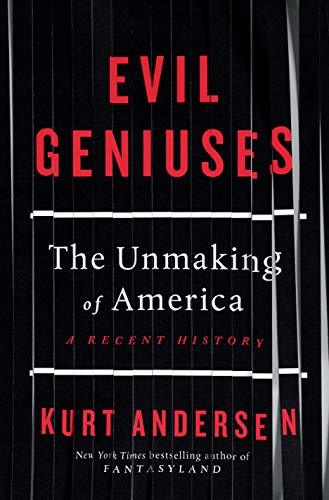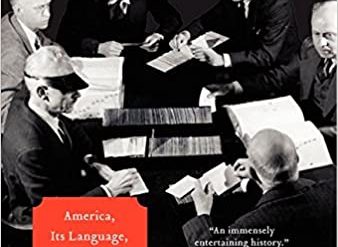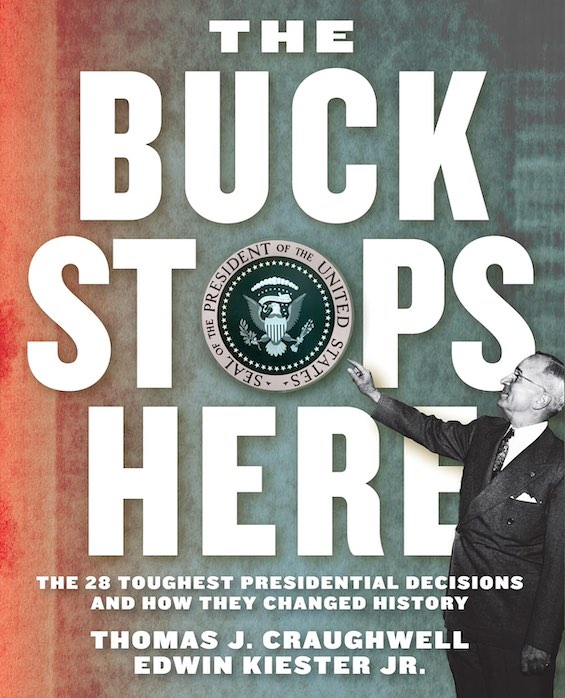
Here is the story of how America lost its way and came to elect a man who rejected democracy itself.
For nearly half a century, the broad-based liberal consensus that grew out of the New Deal produced robust economic growth, rich corporate profits, and an expanding middle class enabled by a powerful labor movement. But it all started fraying in the 1960s with the ascendancy of the civil rights movement, women’s rights, and opposition to the war in Vietnam. The backlash was severe. And beginning around 1970, Big Business and the wealthiest beneficiaries of the US economy resolved to upend the consensus.
Acting alone at first but increasingly in coordination, they undertook a massive campaign to reverse the liberal tax, social welfare, consumer protection, and environmental policies on which American society had come to be based. In Evil Geniuses, author Kurt Andersen dives into the history of this campaign and names the names of the men—they were all men—who pandered to the backlash. He details how they were so successful that the US economy returned to levels of economic inequality not seen for more than a century. And, in cynically indulging the worst impulses unleashed in the backlash to the 60s, they enabled the election in 2016 of a man who revels in the racism, misogyny, authoritarianism, and reactionary policies that even so many of them deplore.
Evil Geniuses: The Unmaking of America by Kurt Andersen (2020) 416 pages ★★★★★

The men responsible for how America lost its way
So, who are these evil geniuses of Andersen’s title? At no point does he list the names, but they emerge clearly enough along the way as he tells the profoundly sad story of the price American society has paid for their folly. These are the principal architects of the winner-take-all economy that gave rise to today’s extreme economic inequality and the madness that placed Donald Trump in the Oval Office:
- Nobel Prize-winning economist Milton Friedman (1912-2006), who led the way toward shareholder primacy that has so tragically distorted the conduct of business in the United States
- Supreme Court Justice Lewis F. Powell Jr. (1907-98), author of the now-famous thirty-four-page memo to the U. S. Chamber of Commerce that set off the rush by the ultrarich and Big Business to destroy the labor movement and seize the reins of government
- Charles Koch (1935-), David Koch (1940-2019), and their billionaire brethren, Richard Mellon Scaife (1932-2014) and John M. Olin (1892-1982), whose “philanthropy” funded the right-wing infrastructure of think tanks and “conservative” university institutes that moved public opinion and the nation’s courts sharply to the right over the past half-century
- Federal judge Robert Bork (1927-2012), who put originalism on the map in legal circles, imposing sophistry on the deliberations of thousands of federal jurists
- Fox News chairman and CEO Roger Ailes (1940-2017), whose unabashed Republican editorializing on-air fostered and sustains today’s sharply polarized political climate
- Former Speaker of the House of Representatives Newt Gingrich (1943-), the take-no-prisoners leader of the Republican Right whose legacy is the ongoing partisan dogfight in Washington
- Anti-tax activist Grover Norquist (1956-), whose single-minded, decades-long campaign against raising any taxes is expressed in the Taxpayer Protection Pledge that virtually all Republicans running for federal office are forced to sign
- Ronald Reagan, the 40th President, whose easygoing manner persuaded millions of Americans to accept economic policies that were demonstrably harmful to all but the rich
- Former President Bill Clinton (1946-), a “New Democrat” whose administration enacted neoliberal economic and criminal justice policies virtually indistinguishable from those of the Radical Right
Obviously, America didn’t lose its way through the efforts of a few men alone. None of these individuals operated in a vacuum. Most exercised their influence through a raft of Right-Wing institutions that proliferated beginning in the late 1960s. In fact, they themselves created many of these entities. Among them were, most notably, the Heritage Foundation, Cato Institute, Business Roundtable, Federalist Society, Club for Growth, Fox News, George Mason University, and ALEC (the American Legislative Exchange Council) as well as older, established groups including the U. S. Chamber of Commerce, National Association of Manufacturers, American Enterprise Institute, and the Wall Street Journal.
So, what did these men accomplish?
Others have written extensively about the economic inequality that these Right-Wing activists engineered. Andersen pays lip service to the statistics, but he is at his best in characterizing the changes. “America’s boats stopped rising together; most of the boats stopped rising at all,” he writes. “But along with economic inequality reverting to the levels of a century ago and earlier, so has economic insecurity, as well as the corrupting political power of big business and the rich . . . while economic immobility is almost certainly worse than it’s ever been.”
All of which pretty much sums up the dilemma we face today: without material change in these facts, American democracy may be unsustainable. In other words, America has lost its way, and without radical change to overturn the Right-Wing revolution that culminated in the election of Donald Trump, we may not be able to find it again. A moderate Democrat with four years in the White House surely cannot turn the tide any more than could King Canute.
A sudden total national immersion in nostalgia?
From the perspective of the “evil geniuses,” the most important changes they’ve wrought are economic. After all, they undertook their campaign a half-century ago to free themselves from labor unions, government regulation, and taxes they regarded as confiscatory. However, Andersen views the history of this period through the lens of social history as well. “One of the ideas underlying this book is that until recently the look and feel of American life dramatically changed every couple of decades, making the world seem continuously new.” He argues—unsuccessfully, in my view—that this is no longer the case and that this has somehow come about as a corollary of the economic and political changes he documents. Implying that America hasn’t just lost its way economically and politically but culturally as well.
Andersen rests his argument on the “sudden total national immersion in nostalgia” for the fashions and popular music of earlier decades. But in a time of constant, seemingly accelerating change, it’s hard to make sense of this perspective. “A nation which always looked forward is now in the process of looking backward,” he writes, “with considerable longing for the real or imagined comforts of the past.” But outside the confines of the fanatics who attend Donald Trump’s rallies and actually believe he wished to “make America great again,” I see little evidence of this. It’s not nostalgia that drives the Right Wing. It’s greed and other, less savory impulses.
What does the future hold?
Andersen professes to be optimistic that over the long term—apparently, a matter of decades—the American people will come to their senses, realize the country has lost its way, and reverse the dystopian course set by the Right beginning in the the 1970s. His optimism seems to rest on two pillars.
Demographics
“Since the 1970s the giant U.S. supermajority of white people without college degrees has shrunk by more than half, down to about 35 percent. They constitute a shrinking fraction that’s now the same size as the fraction of college graduates and the fraction of people of color, both of which are growing.” In other words, Andersen implies, demographics may save our bacon. I just wish I could be convinced that either college graduates or people of color could be counted on to rush to the banner of progressive change. Neither group is in any way monolithic, and the results of the 2020 election suggest cause for concern despite Joe Biden’s seven-million-vote victory. Andersen’s optimism flies in the face of the natural tendency of people to disagree with one another and the vote suppression and other manipulative tactics employed by today’s Republican Party.
Conservative reassessment
Andersen quotes at length from an editorial in that bastion of the conservative economic establishment, the Financial Times (April 3, 2020). The essay was headlined “Virus Lays Bare the Frailty of the Social Contract: Radical Reforms are Required to Forge a Society That Will Work for All.” And the essay is worth reprising at length:
As western leaders learnt in the Great Depression, and after the second world war, to demand collective sacrifice you must offer a social contract that benefits everyone. Today’s crisis is laying bare how far many rich societies fall short of this ideal . . . Better paid knowledge workers often face only the nuisance of working from home [while] economic lockdowns are imposing the greatest cost on those already worst off. . . Radical reforms—reversing the prevailing policy direction of the last four decades—will need to be put on the table. Governments will have to accept a more active role in the economy. They must see public services as investments rather than liabilities . . . Redistribution will again be on the agenda; the privileges of the elderly and wealthy in question. . . Policies until recently considered eccentric, such as basic income and wealth taxes, will have to be in the mix.
If this astonishing reversal by one of the world’s leading conservative papers represents a sea change in the making and not just an aberration, perhaps there is hope and America will find its way again. And Andersen cites as supporting evidence the widely publicized declaration by the Business Roundtable on the”Purpose of a Corporation” (August 19, 2019) that “companies should serve not only their shareholders, but also deliver value to their customers, invest in employees, deal fairly with suppliers and support the communities in which they operate.” Let’s hope.
About the author

Kurt Andersen (1954-) is the author of three novels, three nonfiction books, and five humorous books. He won the Peabody Award for his long-running program on public radio. He lives in Brooklyn with his wife, the author Anne Kreamer.
For further reading
For a review of the book that, in a way, is a prequel to Evil Geniuses, see my review of the author’s Fantasyland: How America Went Haywire (Conspiracy theories, fake news, and other delusions in American history).
Other books that cover some of the same territory and help elucidate how America lost its way include the following:
- Dark Money: The Hidden History of the Billionaires Behind the Rise of the Radical Right by Jane Mayer (How the Koch brothers are revolutionizing American politics)
- Democracy in Chains: The Deep History of the Radical Right’s Stealth Plan for America by Nancy MacLean (Historical perspective on “the vast Right-Wing conspiracy”)
- Transaction Man: The Rise of the Deal and the Decline of the American Dream by Nicholas Lemann (Economic inequality deconstructed in a brilliant historical study)
You might also be interested in: Top 20 popular books for understanding American history, Top 10 nonfiction books about politics (plus dozens of runners-up), and Jackpot: How the Super-Rich Really Live—and How their Wealth Harms Us All by Michael Mechanic (The curious lives of the rich and not-so-famous).
And you can always find my most popular reviews, and the most recent ones, plus a guide to this whole site, on the Home Page.



























